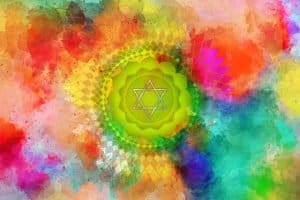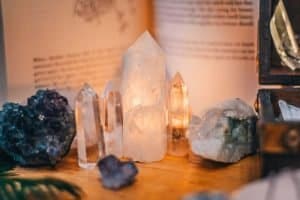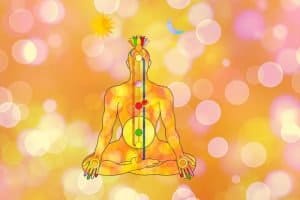Last Updated on August 23, 2022
Many people have different types of chakras that are located on their bodies. Chakras are part of the energy field in which a person’s mind, body, emotions, and spirit are embedded.
In this article, we will discuss how to control your energy centers and use them in your everyday life. We will also provide tips for keeping your chakra balanced!
What is the Chakra System and Why Control it?
In order to control your chakra, you first need to understand what it is and what it does. Chakra is a Sanskrit word that means “wheel” or “disk” which are energy centers, or focal points, where the physical and spiritual energies of a person meet.
There are 7 chakras in the human body, each with its own color and function. They are located in different parts of the body and govern different areas of our lives.
To control and balance your chakra, you need to learn how to focus and move your energy to have more positive well-being. However, when your chakra is out of balance, you may experience physical, emotional, or spiritual problems.
The Seven Main Chakras

These 7 chakras are said to be responsible for different aspects of our lives, such as creativity, intuition, and self-esteem.
Each chakra is located in a different part of the body and can be opened through various means, including meditation and yoga.
Learn more about the 7 chakras below and check how you can control and use them in your daily life!
1. Root chakra (Muladhara)
- Location: Base of your spine
- Color: Red
- Element: Earth
- Associated body: Digestive system, legs, and feet
- Crystal: Hematite, red jasper, and onyx
- Responsible for: Survival needs, security, and stability
Being the first chakra in your body, the Muladhara or root chakra serves as the foundation in your body. Take away the foundation and your energy won’t be able to flow freely in your physical body.
When this chakra is activated, you feel more confident to withstand the challenges you will face because you are grounded and secured in your life. As a result, you tend to worry less when your basic needs for survival such as water, food, and safety are met.
Symptoms of a blocked root chakra
If the needs of your root chakra can’t be met (or if there is too much energy), this can lead to chakra blockage:
- You feel anxious and ungrounded
- Constant worrying about your safety
- Digestive issues
How to control it?
- Any balancing yoga poses can do the trick like the warrior or mountain pose, wide-legged forward pose, and the malasana squats.
- Ground yourself and feel the earth below you. For example, take a moment with nature and feel as your energy flow within you.
2. Sacral chakra (Svadhisthana)
- Location: Within the lower abdomen, just below your navel
- Color: Orange
- Element: Water
- Associated body: Reproductive system, hips, bladder, kidneys, and lower back
- Crystal: Tiger’s eye, sunstone, and carnelian
- Responsible for: Creative and sexual energy
Svadhisthana or sacral chakra is the second chakra that is considered to be the most fun out of all the seven chakras. Governing our body’s emotions, passions, and pleasures, this chakra is where our deepest sensations and emotions are expressed.
Having an open sacral chakra makes you more passionate, happier, and live an abundant life.
Symptoms of a blocked sacral chakra
Sacral chakra blockage can lead to the following symptoms:
- You feel less in control of your life
- You may suffer from addiction, hormonal, and fertility issues
- Emotional instability
- Physical sexual dysfunction
How to control it?
- Perform yoga poses to strengthen your pelvic floor muscles such as pigeon and goddess pose.
- Express your artistic side with tasks such as painting, cooking, gardening -anything that allows you to create!
3. Solar plexus chakra (Manipura)
- Location: Within the upper abdomen in your stomach area
- Color: Yellow
- Element: Fire
- Associated body: Stomach, liver, spleen, pancreas, and gallbladder
- Crystal: Amber, citrine, and pyrite
- Responsible for: Self-confidence and self-esteem
Also known for being the navel chakra, the third chakra is the solar plexus chakra or Manipura. Your inner fire and power rest in here which fuels your confidence.
If this energy center is activated, you tend to believe in yourself more due to your strong willpower.
Symptoms of a blocked solar plexus chakra
A blocked solar plexus chakra manifests itself through the following:
- You feel insecure and full of shame and doubt
- Indigestion and other weight issues
- Weak will
- Difficulty making decisions
How to control it?
- Firing up your core with poses like triangle or boat pose is recommended to balance this chakra.
- Increase your confidence and willpower by saying words of affirmation.
- Create a checklist of your goals and stick to it – regardless of how easy or difficult it could be.
4. Heart chakra (Anahata)
- Location: Center of your chest
- Color: Green
- Element: Air
- Associated body: Circulatory system, heart, lungs, and arms
- Crystal: Jade, malachite, and rose quartz
- Responsible for: Love and compassion
The Anahata or heart chakra is the fourth chakra in the body and is the bridge between the lower chakras (associated with material things) and the upper chakras (associated with spirituality).
Given its name, this heart center is where love, compassion, and good vibes are expressed when activated; therefore, forgiveness comes easy for a person who has nurtured this.
Symptoms of a blocked heart chakra
Here are some symptoms of a person who may have a blocked heart chakra:
- Respiratory or heart issues
- Hard time opening up to others
- Tendencies to hold grudges
- You feel more negative emotions such as anger, jealousy, and loneliness
How to control it?
- Open up yourself more and embrace others with heart opener positions like the wheel or camel pose.
- Find things to be grateful for in your life. Expressing gratitude can increase your positive emotions and improve your well-being.
5. Throat chakra (Vishuddha)
- Location: Throat
- Color: Light blue or turquoise
- Element: Ether
- Associated body: Thyroid, jaw, neck, tongue, mouth, and throat
- Crystal: Aquamarine, kyanite, and lapis lazuli
- Responsible for: Communication and inner truths
Expressing oneself and honoring your truths is located in this fifth chakra. Vishuddha or throat chakra rules all communication and is the first among the remaining chakras to focus on spiritual energy.
As a result, this chakra allows you to fully listen and express yourself clearly when balanced.
Symptoms of a blocked throat chakra
People who have a blocked throat chakra tends to experience:
- Difficulty expressing yourself to others
- Difficulty paying attention to what others are saying
- Tensions in parts of your body associated with this chakra
How to control it?
- Open up both the back and front sides of your neck with the plow pose or fish pose.
- Keep a journal and express yourself freely through writing.
- Encourage your throat to open up by reciting a healing chant, mantra, or song.
6. Third eye chakra (Ajna)
- Location: Between your eyebrows, center of forehead
- Color: Indigo or purple
- Element: Light
- Associated body: Pituitary glands, eyes, ears
- Crystal: Amethyst, labradorite, purple fluorite
- Known for: Intuition and imagination
The next and sixth chakra is the third eye chakra (also known as Ajna chakra) where your intuition and sixth sense dwell. Moreover, the word “third eye” in this energy center is known universally for its ability to perceive things in a bigger picture and beyond the surface level.
Symptoms of a blocked third eye chakra
Your third eye chakra may be blocked if you are experiencing the following symptoms:
- Difficulty recalling information and learning new things
- Regular headaches, confusion, and nightmares
- Mental health issues like anxiety and depression
How to control it?
- Connect your upper body to your lower body with poses like the forward fold or forward eagle. Likewise, this connection allows your higher self to connect with the rooted parts of your body.
- Meditate and disengage yourself from any outside senses. Focus on yourself, breathe deeply, and experience the here-and-now.
7. Crown chakra (Sahasrara)
- Location: Top of your head
- Color: Violet
- Element: Thought
- Associated body: Pineal gland, cerebral cortex
- Crystal: Clear quartz, lepidolite, selenite
- Known for: Spiritual connection to self, others, and the universe
Finally, the last and seventh chakra is the Sahasrara, or crown chakra. This highest chakra allows you to access a higher consciousness which not all people can do.
When aligned, Sahasrara liberates you and gives you the wisdom to connect spiritually and experience awakening.
Symptoms of a blocked crown chakra
A blocked crown chakra gives you symptoms like:
- Disconnection from the world
- Lack of direction and purpose
How to control it?
- Performing savasana or corpse pose helps strengthen your crown chakra. This pose allows you to reflect and remind yourself about your roots and where you should be moving forward.
- Daily practice of previous techniques like meditation, yoga, and gratitude.
Conclusion

In conclusion, controlling your chakra is a powerful way to improve your life. By understanding how to use and control your chakra, you can start to see positive changes in all areas of your life.
With practice, you can learn to use your energy to manifest your desires, improve your health, and connect with the universe. So what are you waiting for? Start practicing today!



